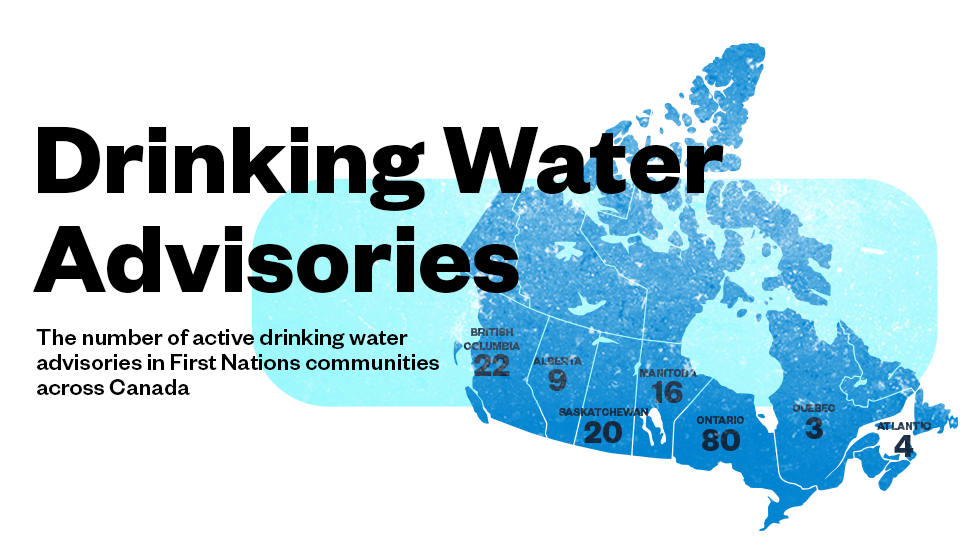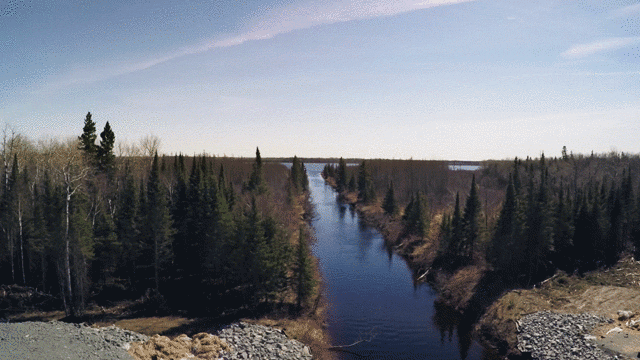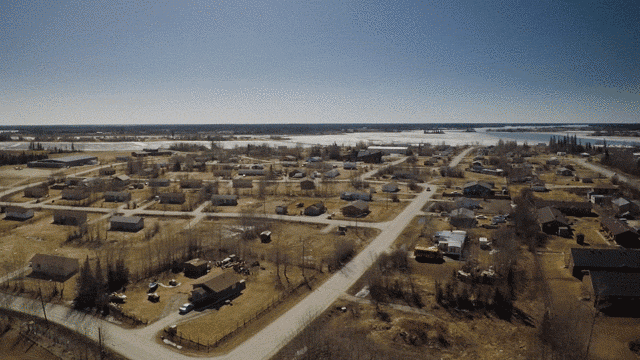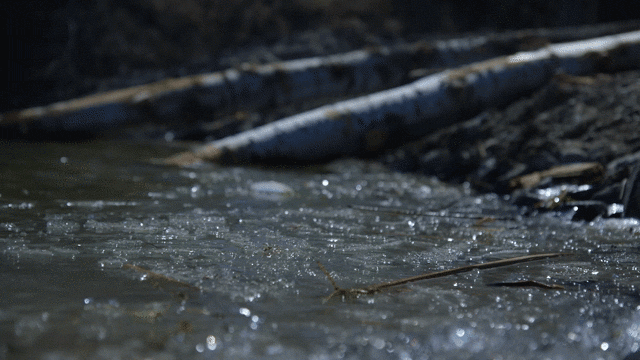Justin Trudeau’s government is claiming to have solved 26 long term drinking water advisories on 22 First Nations — something it says represents good progress on a key election promise made by the Liberals nearly two years ago.But a VICE News fact check has found that while 14 communities on that list concur with that assessment, some of them told us they still face major issues — including lack of government funding for water operators and problems with leaky, poorly designed systems — that make that status precarious.We were unable to reach water operators in the other eight communities.Most of the 26 advisories were solved through investments of government funding — however the department of Indigenous and Northern Affairs would not say how much of that money was spent under the Conservatives versus the Liberals.Furthermore, the number of communities affected has actually gone up, underscoring the difficulty that Trudeau will have in actually delivering on a promise he first made in 2015, at a VICE-hosted town hall, to solve all drinking water advisories on First Nations within five years.“If I made promises it’s because I intend to keep them,” Trudeau told Sarain Carson-Fox, host of the VICELAND show RISE, while visiting Shoal Lake 40 last year, a reserve on the border of Manitoba and Ontario that has been on a boil water advisory for two decades.Nearly two years into the Liberal mandate, he is still a long way from fulfilling his promise. Back in July 2015, before he was elected, there were 114 First Nations under 159 drinking water advisories across Canada. (Drinking water advisories can affect as little as one building or an entire First Nation, so communities can have more than one advisory at a time.)Fast forward to this year, and as of July 31, 2017, there were a total of 121 First Nations under 172 drinking water advisories across Canada, including B.C.Those numbers are a tally of the advisories listed by Health Canada and the B.C. First Nations Health Authority. It does not include advisories in the Saskatoon Tribal Council, which represents about 11,000 people within a 200 kilometre radius of Saskatoon, and which deals with its own water.The number also does not include some water insecure Indigenous communities that the government contends it is not responsible for. In March, VICE News profiled the small Labrador town of Black Tickle, whose residents have to travel three kilometres round trip to fetch drinking water.Update (September 5, 4:10pm): Numbers provided by Indigenous and Northern Affairs, looking specifically at water systems managed by the federal government on First Nations reserves, show that there were, as of June, 69 long-term drinking water advisories — down only slightly from 77 long-term advisories as of November 2015.Crown-Indigenous Relations and Northern Affairs Minister Carolyn Bennett has travelled across the country in recent months, committing money for water filtration plans, and touting the success that her government has had in tackling the crisis. Yet not all the communities that have had their water problems “fixed” see it that way.In June, Indigenous Affairs sent VICE News a list of 22 communities it claimed now have clean drinking water and said it was thanks to investments made under both the Liberal and Conservative governments.In June and July, VICE News called all 22 communities on the department’s list to check if what the government said was true. Our previous fact check last October found many communities did not have clean water when Indigenous Affairs said they did. At the time, the department blamed the discrepancy on Health Canada, saying their list was not up to date.This time, 14 communities confirmed that they do have clean drinking water. Of those, three said they face ongoing serious issues that could threaten that status in the future.VICE News Canada is spending this week focusing on the Indigenous water crisis. Read more here.
Back in July 2015, before he was elected, there were 114 First Nations under 159 drinking water advisories across Canada. (Drinking water advisories can affect as little as one building or an entire First Nation, so communities can have more than one advisory at a time.)Fast forward to this year, and as of July 31, 2017, there were a total of 121 First Nations under 172 drinking water advisories across Canada, including B.C.Those numbers are a tally of the advisories listed by Health Canada and the B.C. First Nations Health Authority. It does not include advisories in the Saskatoon Tribal Council, which represents about 11,000 people within a 200 kilometre radius of Saskatoon, and which deals with its own water.The number also does not include some water insecure Indigenous communities that the government contends it is not responsible for. In March, VICE News profiled the small Labrador town of Black Tickle, whose residents have to travel three kilometres round trip to fetch drinking water.Update (September 5, 4:10pm): Numbers provided by Indigenous and Northern Affairs, looking specifically at water systems managed by the federal government on First Nations reserves, show that there were, as of June, 69 long-term drinking water advisories — down only slightly from 77 long-term advisories as of November 2015.Crown-Indigenous Relations and Northern Affairs Minister Carolyn Bennett has travelled across the country in recent months, committing money for water filtration plans, and touting the success that her government has had in tackling the crisis. Yet not all the communities that have had their water problems “fixed” see it that way.In June, Indigenous Affairs sent VICE News a list of 22 communities it claimed now have clean drinking water and said it was thanks to investments made under both the Liberal and Conservative governments.In June and July, VICE News called all 22 communities on the department’s list to check if what the government said was true. Our previous fact check last October found many communities did not have clean water when Indigenous Affairs said they did. At the time, the department blamed the discrepancy on Health Canada, saying their list was not up to date.This time, 14 communities confirmed that they do have clean drinking water. Of those, three said they face ongoing serious issues that could threaten that status in the future.VICE News Canada is spending this week focusing on the Indigenous water crisis. Read more here. Water plant operator Dave Craig confirmed to VICE News that Pic Mobert First Nation in northwestern Ontario finally has clean water, ending a long term drinking water advisory stretching back to early 2008.“It’s a welcome relief for everybody, there’s no doubt about that,” he told VICE News. “The people are elated — they’ve been carrying jugs of water for more than a decade.”“Once these facilities are built on First Nations, more emphasis should be on keeping them running. Because they have a tendency to neglect them afterwards. You have to jump through all the hoops to get the funding, and a lot of these places fall into disrepair after.”Indigenous Affairs said Trudeau’s Liberal government had spent $13.3 million on Pic Mobert’s water plant and distribution system since November 2015, but Craig said it was actually funded under the Conservatives. Indigenous Affairs corrected its mistake after VICE News confronted the department about its misinformation.“You really can’t credit one government or another,” Craig said. “The process for this place getting a water treatment plant took ages.” The initial process to get the plant began when he first started training as a water operator in ‘97 or ‘98. He said bureaucracy was to blame for the delay.“If it were a municipality it would be an uproar,” added Craig. “First Nations in the north are ignored — out of sight, out of mind. They’re put on the backburner.”“It’s stupid,” he said. “It’s neglectful.”
Water plant operator Dave Craig confirmed to VICE News that Pic Mobert First Nation in northwestern Ontario finally has clean water, ending a long term drinking water advisory stretching back to early 2008.“It’s a welcome relief for everybody, there’s no doubt about that,” he told VICE News. “The people are elated — they’ve been carrying jugs of water for more than a decade.”“Once these facilities are built on First Nations, more emphasis should be on keeping them running. Because they have a tendency to neglect them afterwards. You have to jump through all the hoops to get the funding, and a lot of these places fall into disrepair after.”Indigenous Affairs said Trudeau’s Liberal government had spent $13.3 million on Pic Mobert’s water plant and distribution system since November 2015, but Craig said it was actually funded under the Conservatives. Indigenous Affairs corrected its mistake after VICE News confronted the department about its misinformation.“You really can’t credit one government or another,” Craig said. “The process for this place getting a water treatment plant took ages.” The initial process to get the plant began when he first started training as a water operator in ‘97 or ‘98. He said bureaucracy was to blame for the delay.“If it were a municipality it would be an uproar,” added Craig. “First Nations in the north are ignored — out of sight, out of mind. They’re put on the backburner.”“It’s stupid,” he said. “It’s neglectful.” Taykwa Tagamou Chief Dwight Sutherland confirmed to VICE News that his northern Ontario community finally has clean drinking water after upgrades to their water system. The Department of Indigenous Affairs said it invested $379,000 to improve filtration at its water plant.The problem they’re having now is they can’t afford to pay their water technician, who is getting job offers at much higher salaries from nearby mining companies.
Taykwa Tagamou Chief Dwight Sutherland confirmed to VICE News that his northern Ontario community finally has clean drinking water after upgrades to their water system. The Department of Indigenous Affairs said it invested $379,000 to improve filtration at its water plant.The problem they’re having now is they can’t afford to pay their water technician, who is getting job offers at much higher salaries from nearby mining companies. INAC says it has finally solved the water issues in Potlotek, a First Nation in Cape Breton, Nova Scotia with investments of $788,000 since November 2015. Band Councillor Quentin Doucette, who is also director of public works and housing, said his community has clean water — “for now.”“We never have a problem this time of year,” he said. “Fall will be the test.”
INAC says it has finally solved the water issues in Potlotek, a First Nation in Cape Breton, Nova Scotia with investments of $788,000 since November 2015. Band Councillor Quentin Doucette, who is also director of public works and housing, said his community has clean water — “for now.”“We never have a problem this time of year,” he said. “Fall will be the test.”
Advertisement

Advertisement
Advertisement

Pic Mobert
He said a new water treatment plant went into commission on Aboriginal Day on June 21, 2016, but that only the north side of the community was hooked up at the time. The community has a north side and a south side, with five kilometres of water pipes in between. The south side was finally connected in December, giving the whole community clean water.Even so, Craig says there are ongoing issues.A small trailer on the south side and the community’s school still has their water delivered, but the community expects that to be fixed soon.On the more urgent side, Craig said the water distribution system has major leaks and is missing equipment.“I’m desperate,” he said. “I want this done before winter. I should only be using 10 cubic metres of water per day for the south community and I’m over 100. Those are big leaks.”“First Nations in the north are ignored — out of sight, out of mind.”
Advertisement

Taykwa Tagamou
Advertisement
“We’re telling Indian Affairs our big issue is we need more money to pay our [water operator],” Sutherland said. “I said: ‘Can’t you increase his wage?’”Band Councillor Bruce Archibald, who is in charge of water in the community, said Indigenous Affairs is only providing $100,000 a year to cover the wages of three water operators, plus the cost of the chemicals, chlorine and other equipment they need to work. Archibald said he had asked the department several times for an increase. “To this date, they have not committed to anything.”Archibald said water system upgrades took seven years to complete after they were approved in 2009 fiscal year. It took five years for INAC to send the First Nation the funding, and another two years to complete the upgrades. It was those upgrades that took Taykwa Tagamou off their drinking water advisory.Archibald doubts it would have taken this long in a non-Indigenous community.“It seems like they don’t understand,” said Sutherland. “I’d like to see these Indian Affairs people come here and live like we do.”“Indian Affairs doesn’t really support us,” the chief continued. “It’s a struggle, it’s absolutely a daily struggle to be Aboriginal.”“It’s a struggle, it’s absolutely a daily struggle to be Aboriginal.”

Potlotek
Advertisement
Last October, Potlotek made headlines after residents posted photos of filthy black water flowing from the taps. At the time, the Department of Indigenous Affairs claimed the water in Potlotek was drinkable.Every fall, the lake the community sources its water from becomes more turbid, stirring up manganese and iron, which the water plant can’t filter out, Doucette said.This year, Potlotek plans to install a limestone contact chamber inside the water plant that should help filter out the manganese and iron.Doucette says he’s cautiously optimistic.“I want to take a wait and see to see what happens with it. It should work, but we’re not going to know until the time comes. For now, the water is OK.”Doucette says he’s cautiously optimistic.